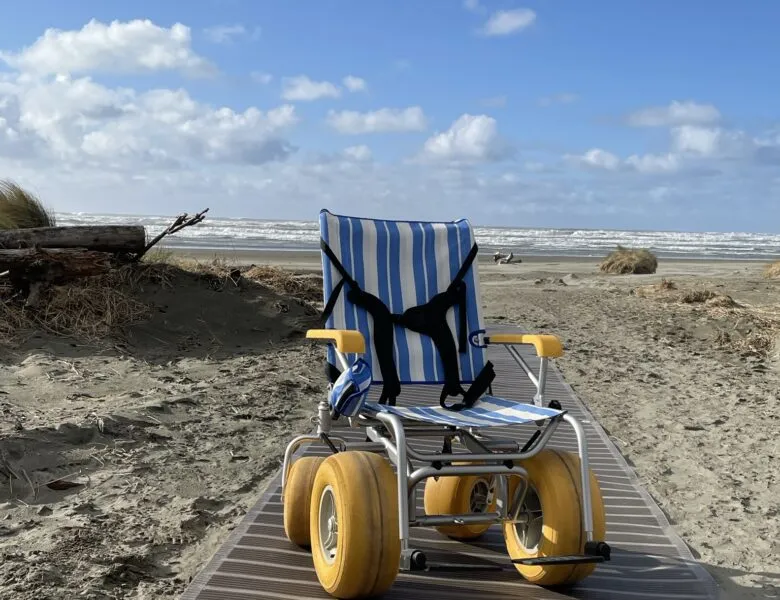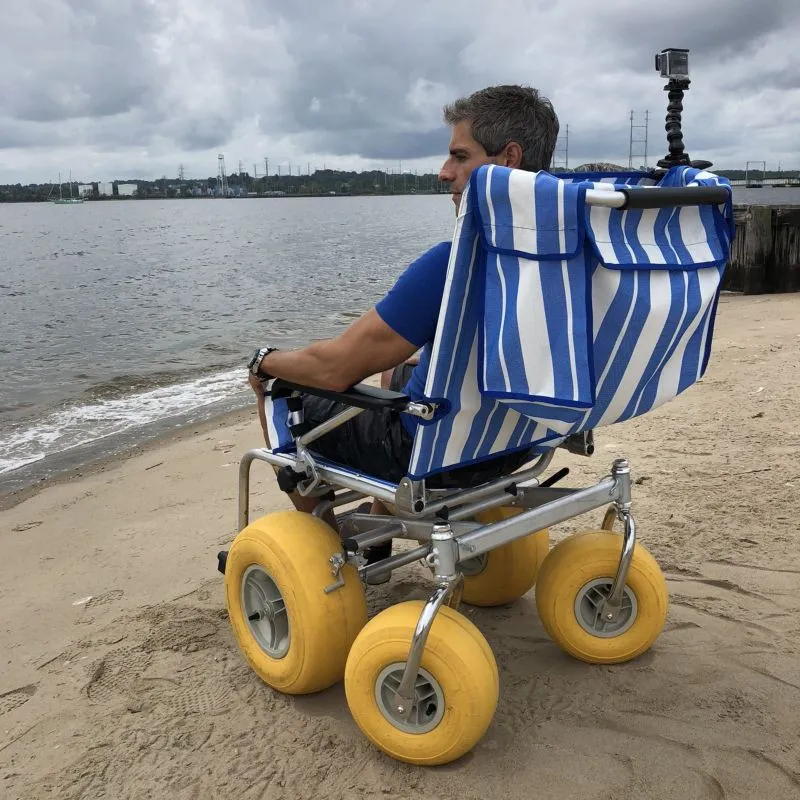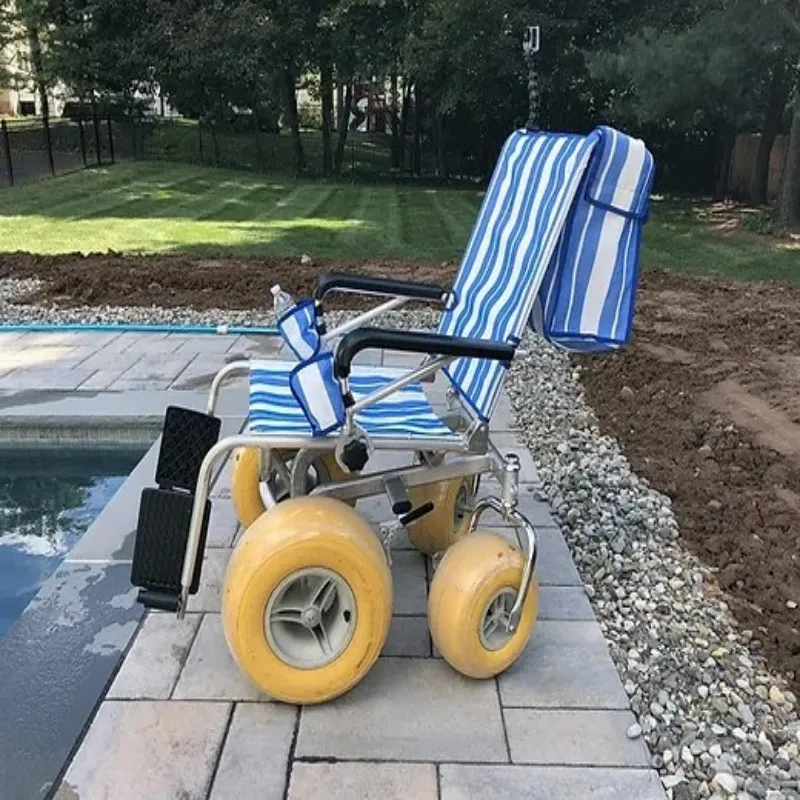Enjoying the beach is a universal pleasure that everyone deserves to experience, regardless of mobility challenges. However, standard wheelchairs are notoriously ineffective on sand, often becoming stuck and creating frustrating, sometimes impossible situations for users and caregivers alike. Selecting the best wheelchair for beach sand requires understanding specific design features that overcome these unique challenges. This comprehensive guide will help you navigate the options available and make an informed decision that ensures seamless shore experiences for yourself or your loved ones.
Understanding Beach Wheelchairs
Beach wheelchairs represent specialized mobility solutions specifically engineered to address the unique challenges presented by sandy environments. Unlike standard wheelchairs designed primarily for solid, flat surfaces, beach wheelchairs incorporate design elements that prevent sinking and facilitate smooth movement across loose sand.
The Challenge of Sand Mobility
Traditional wheelchairs face several significant obstacles when used on beach sand:
- Sinking Effect: Standard narrow wheels concentrate weight in a small area, causing them to sink deeply into soft sand.
- High Rolling Resistance: Sand creates tremendous resistance against conventional wheels, making forward movement extremely difficult.
- Stability Issues: Uneven sandy terrain compromises the stability of standard wheelchairs, creating potential safety hazards.
- Corrosion Concerns: Beach environments expose equipment to salt, moisture, and sand particles that can damage standard wheelchair components.
These challenges have historically limited beach access for wheelchair users, creating barriers to one of nature’s most beloved recreational environments.

Evolution of Beach Wheelchair Design
The development of specialized beach wheelchairs represents a significant advancement in adaptive equipment design. Early beach wheelchairs were often bulky, difficult to transport, and required substantial assistance to operate. Modern designs have evolved considerably, with innovations focusing on:
- Material Science: Utilizing lightweight, corrosion-resistant materials that withstand harsh beach environments.
- Wheel Technology: Developing specialized wheels that distribute weight effectively across sand surfaces.
- Ergonomic Considerations: Creating comfortable seating systems that accommodate extended beach visits.
- Portability Solutions: Engineering folding and disassembly mechanisms that facilitate easier transportation.
Ary Medical has been at the forefront of this evolution, incorporating user feedback and technological advancements into their beach wheelchair designs. Their commitment to continuous improvement has resulted in models that offer unprecedented independence and comfort in beach environments.
Key Features and Benefits of Beach Wheelchairs
The best wheelchairs for beach sand incorporate several essential features that directly address the challenges of sandy environments. Understanding these features helps in evaluating different models and selecting the option that best meets individual needs.
Wide Balloon Wheels
The most distinctive feature of beach wheelchairs is their specialized wheel design:
- Surface Area Distribution: Wide balloon wheels distribute the user’s weight across a much larger surface area, preventing sinking into soft sand.
- Flotation Properties: Many balloon wheels incorporate materials that provide buoyancy, allowing some models to float in shallow water.
- Traction Enhancement: Specialized tread patterns improve grip on loose sand without becoming clogged with sand particles.
- Puncture Resistance: Quality beach wheelchair wheels feature puncture-resistant construction to withstand sharp shells and beach debris.
Ary Medical’s beach wheelchairs feature proprietary balloon wheel technology that provides 60% more surface contact than standard beach wheelchair wheels, significantly improving stability and ease of movement.
Corrosion-Resistant Materials
Beach environments present harsh conditions that can quickly damage standard mobility equipment:
- Marine-Grade Aluminum: Lightweight frames that resist salt corrosion and oxidation.
- Stainless Steel Components: Hardware and fasteners designed to withstand constant exposure to moisture and salt.
- UV-Resistant Plastics: Components that won’t degrade or become brittle with sun exposure.
- Sealed Bearings: Wheel bearings protected from sand infiltration that can cause grinding and premature failure.
These materials ensure longevity and reliable performance even with regular beach use, protecting your investment and ensuring consistent functionality.
Ergonomic Design for Beach Comfort
Extended beach visits require seating systems designed for comfort in outdoor environments:
- Breathable Fabrics: Mesh materials that allow airflow and quick drying after water exposure.
- Adjustable Positioning: Recline features and adjustable footrests to accommodate different comfort preferences.
- Pressure Distribution: Seating designed to prevent pressure points during extended sitting periods.
- Sun Protection Options: Some models include attachable canopies or umbrella mounts to provide shade.
Ary Medical incorporates ergonomic principles developed through extensive user testing, resulting in beach wheelchairs that remain comfortable even during all-day beach excursions.
Types of Beach Wheelchairs
Beach wheelchairs come in several distinct categories, each designed to meet different needs and preferences. Understanding these categories helps in narrowing down options to find the best match for specific requirements.
Manual Push Beach Wheelchairs
These wheelchairs require an assistant to push and navigate:
- Simplicity: Fewer mechanical components mean less maintenance and fewer potential failure points.
- Affordability: Generally less expensive than self-propelled or powered options.
- Lightweight Design: Typically lighter and easier to transport than other types.
- Reliability: No batteries or motors to fail, providing consistent performance.
Manual push models are ideal for occasional beach visits or situations where assistance is readily available. They represent an excellent entry-level option for many users.
Self-Propelled Beach Wheelchairs
Designed for users with sufficient upper body strength to navigate independently:
- Independence: Allows users to control their own movement and direction without assistance.
- Hand Rims: Specialized, sand-friendly propulsion rims that provide effective grip without requiring excessive force.
- Adjustable Axle Positions: Customizable wheel positioning to accommodate different user strengths and abilities.
- Braking Systems: Effective braking mechanisms designed to work in sandy conditions.
Self-propelled models empower users with the freedom to explore beaches at their own pace, significantly enhancing the sense of independence and enjoyment.
Powered Beach Wheelchairs
Incorporating electric motors for effortless navigation:
- Minimal Effort: Requires no physical exertion from either the user or caregivers.
- Extended Range: Ability to cover greater distances across the beach without fatigue.
- Precise Control: Joystick or control systems that provide accurate directional control.
- Power Management: Battery systems designed for beach environments with indicators to prevent unexpected power loss.
While typically more expensive and heavier than non-powered alternatives, these models offer unmatched independence for users with limited upper body strength or caregivers who cannot provide physical assistance.
Amphibious Beach Wheelchairs
Specialized models designed to transition from sand to water:
- Floating Capability: Buoyant components that support the user safely in water.
- Water-Safe Electronics: In powered models, sealed systems that can withstand water exposure.
- Transition Design: Features that facilitate smooth movement between sand and water environments.
- Safety Mechanisms: Additional securing systems to maintain user safety during water activities.
Amphibious models like those offered by Ary Medical provide the most complete beach experience, allowing users to enjoy both the shore and water activities with a single mobility solution.

Selecting the Right Beach Wheelchair
Choosing the best wheelchair for beach sand requires careful consideration of several factors to ensure it meets the specific needs of the user and the environments where it will be used.
User-Specific Considerations
The right beach wheelchair should be selected based on the unique needs of its user:
- Weight Capacity: Verify that the wheelchair can safely support the user’s weight, with most quality models accommodating between 250-350 pounds (113-159 kg).
- User’s Physical Abilities: Consider whether the user has the upper body strength for self-propulsion or will rely on caregiver assistance.
- Transfer Requirements: Evaluate how easily the user can transfer into and out of the chair, considering seat height and armrest design.
- Seating Support Needs: Assess whether the user requires additional head, neck, or trunk support beyond what’s standard.
For users with specific medical considerations, consulting with a physical therapist or occupational therapist can help identify the most appropriate features to look for in a beach wheelchair.
Beach Environment Factors
The specific beach environments where the wheelchair will be used should influence your selection:
- Sand Type: Finer, softer sand requires wider wheels compared to packed or coarse sand.
- Beach Slope: Steeper beaches may require chairs with enhanced stability features and stronger braking systems.
- Distance to Water: If the chair will need to travel long distances across sand, prioritize models with easier propulsion systems.
- Water Activities: If water entry is desired, an amphibious model becomes essential.
Ary Medical offers customization options that allow their beach wheelchairs to be optimized for specific beach environments, ensuring maximum performance in the conditions where they’ll be most frequently used.
Practical Considerations
Beyond user needs and environmental factors, practical aspects of ownership should be evaluated:
- Portability: Consider whether the chair needs to be transported frequently and how easily it can be disassembled or folded.
- Storage Requirements: Evaluate the space needed to store the wheelchair when not in use.
- Maintenance Needs: Research the maintenance requirements, including cleaning procedures and part replacement.
- Cost and Availability: Balance budget constraints with the features needed, considering both purchase and potential rental options.
Many coastal communities now offer rental programs for beach wheelchairs, which can be an excellent option for occasional users or travelers who cannot transport their own equipment.
Usage Tips and Best Practices
Maximizing the benefits of a beach wheelchair requires proper usage techniques and preparation. Following these best practices ensures a safe and enjoyable experience for both users and caregivers.
Pre-Beach Preparation
Proper preparation before heading to the beach significantly enhances the experience:
- Equipment Check: Inspect all components for damage or wear before each use, paying special attention to wheels, brakes, and seating supports.
- Beach Research: Identify beaches with accessible facilities including parking, pathways, and restrooms.
- Weather Assessment: Check tide schedules and weather conditions to plan the outing during optimal conditions.
- Packing Essentials: Bring along items like towels, sun protection, hydration, and any personal adaptive equipment.
Creating a checklist of essential items helps ensure nothing important is forgotten and allows for a more relaxed beach experience.
Navigation Techniques
Effective navigation techniques can significantly improve the beach wheelchair experience:
- Path Selection: Look for firmer sand near the water’s edge for easier rolling.
- Momentum Management: Maintain steady momentum when possible, as starting from a complete stop requires more effort.
- Turning Methods: Make wide, gradual turns rather than sharp ones to prevent wheels from digging into the sand.
- Obstacle Approach: Navigate around rather than over obstacles when possible to maintain stability.
For powered beach wheelchairs, understanding the specific control systems and practicing in less crowded areas first can help build confidence and skill.
Maintenance and Care
Proper maintenance extends the life of a beach wheelchair and ensures continued safe operation:
- Post-Use Rinse: Thoroughly rinse the entire chair with fresh water after each use to remove salt, sand, and other debris.
- Dry Completely: Allow the chair to dry completely before storage to prevent mold, mildew, and corrosion.
- Regular Inspection: Check moving parts, fasteners, and wheels regularly for signs of wear or damage.
- Proper Storage: Store the wheelchair in a cool, dry place, protected from direct sunlight which can degrade materials over time.
Following the manufacturer’s specific maintenance guidelines is essential, as different models may have unique care requirements based on their materials and construction.
User Experiences and Case Studies
The true value of beach wheelchairs is best understood through the experiences of those whose lives they’ve transformed. These real-world examples illustrate the profound impact of beach accessibility.
Michael’s Story: Rediscovering Family Tradition
Michael, a 58-year-old veteran who lost mobility after a service-related injury, had given up on beach visits despite living just miles from the coast. “The beach was where my family always gathered,” he explains. “Missing those gatherings was one of the hardest parts of adjusting to life in a wheelchair.”
After his children researched options and purchased an Ary Medical beach wheelchair, Michael was able to rejoin family beach traditions. “The first time I rolled across the sand without getting stuck was emotional,” he recalls. “But watching my grandchildren play in the waves while sitting comfortably at the shoreline—that was priceless.”
The chair’s stability on sand and comfortable seating allowed Michael to spend entire days at the beach without discomfort, reconnecting him with a cherished family tradition.
Coastal Community Initiatives
Many coastal communities have recognized the importance of beach accessibility and implemented beach wheelchair programs:
- Cape May, New Jersey offers free beach wheelchair loans at multiple beach entrances, serving thousands of visitors annually.
- Sydney, Australia has implemented an award-winning accessible beaches program featuring beach wheelchairs at 15 popular beaches, significantly increasing tourism from families with disabled members.
- Cornwall, UK created a beach wheelchair network allowing users to reserve chairs at various beaches throughout the region, ensuring availability during peak tourist seasons.
These programs demonstrate that relatively modest investments in accessibility equipment yield significant benefits for both community members and visitors.
The Future of Beach Wheelchair Technology
As awareness of accessibility needs grows and technology advances, the future of beach wheelchairs looks promising with several emerging trends.
Technological Innovations
Emerging technologies are expanding the possibilities for beach

